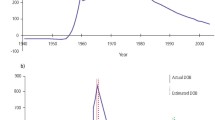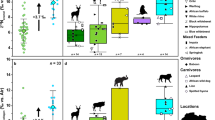Abstract
THE L-amino acids initially present in bone protein undergo slow racemisation over geological time at a rate which is proportional to temperature1,2. We have shown3 that at the human body temperature of ∼37°C aspartyl residues in tooth enamel protein also undergo racemisation at a rate which corresponds to an enrichment in the D-aspartic acid content of ∼0.1% per year. No D-aspartic acid increase was detected in haemoglobin, a protein with a more rapid turnover. We concluded that D-aspartyl residues accumulate in the metabolically stable protein in tooth enamel during the human lifetime as a result of in situ racemisation. We proposed that the irreversible first-order rate equation calculated from the enamel results could be used to deduce the age of any stable protein from a long lived mammal and thus the age of the organism itself. The error among samples from old individuals was large, however, probably because attrition and caries reduce the amount of uncontaminated enamel, and thus tend to limit the usefulness of tooth enamel for age determinations. In this report, we show that tooth dentine is a more suitable material, and the extent of aspartic acid racemisation in this fraction can be used as a reliable indicator of mammalian age.
This is a preview of subscription content, access via your institution
Access options
Subscribe to this journal
Receive 51 print issues and online access
$199.00 per year
only $3.90 per issue
Buy this article
- Purchase on Springer Link
- Instant access to full article PDF
Prices may be subject to local taxes which are calculated during checkout
Similar content being viewed by others
References
Bada, J. L., and Helfman, P. M., World Archaeol., 7, 160–173 (1975).
Schroeder, R. A., and Bada, J. L., Science, 182, 479–482 (1973).
Helfman, P. M., and Bada, J. L., Proc. natn. Acad. Sci U.S.A., 72, 2891–2894 (1975).
Blackburn, S., and Lee, G. R., Biochem. J., 58, 227–231 (1954).
Bada, J. L., and Protsch, R., Proc. natn. Acad. Sci. U.S.A., 70, 1331–1334 (1973).
Philippas, G. G., and Applebaum, E., J. dent. Res., 45, 778–789 (1966).
Butler, W. T., in The Comparative Molecular Biology of Extracellular Matrices (edit. by Slavkin, H. C.), 255–260 (Academic, New York, 1972).
Weatherell, J. A., and Robinson, C., in Biological Mineralization (edit. by Zipkin, I.), 43–74 (Wiley, New York, 1973).
Spector, W. S., (ed.), Handbook of Biological Data, 343 (Saunders, Philadelphia, 1956).
Bada, J. L., Kvenvolden, K. A., and Peterson, E., Nature, 245, 308–310 (1973).
Author information
Authors and Affiliations
Rights and permissions
About this article
Cite this article
HELFMAN, P., BADA, J. Aspartic acid racemisation in dentine as a measure of ageing. Nature 262, 279–281 (1976). https://doi.org/10.1038/262279b0
Received:
Accepted:
Published:
Issue Date:
DOI: https://doi.org/10.1038/262279b0
This article is cited by
-
Biochemical analyses for dental age estimation: a review
Egyptian Journal of Forensic Sciences (2022)
-
Reliability of aspartic acid racemization rate for chronological age estimation—a systematic review and meta-analysis
International Journal of Legal Medicine (2022)
-
Evolution of dental age estimation methods in adults over the years from occlusal wear to more sophisticated recent techniques
Egyptian Journal of Forensic Sciences (2021)
-
Isomerization of Aspartyl Residue in Amyloid Beta Fragments: The Kinetics by Real-Time 1H NMR Under Neutral and Basic Conditions
Journal of Solution Chemistry (2020)
-
Aspartic acid racemization of root dentin used for dental age estimation in a Polish population sample
Forensic Science, Medicine and Pathology (2018)
Comments
By submitting a comment you agree to abide by our Terms and Community Guidelines. If you find something abusive or that does not comply with our terms or guidelines please flag it as inappropriate.



